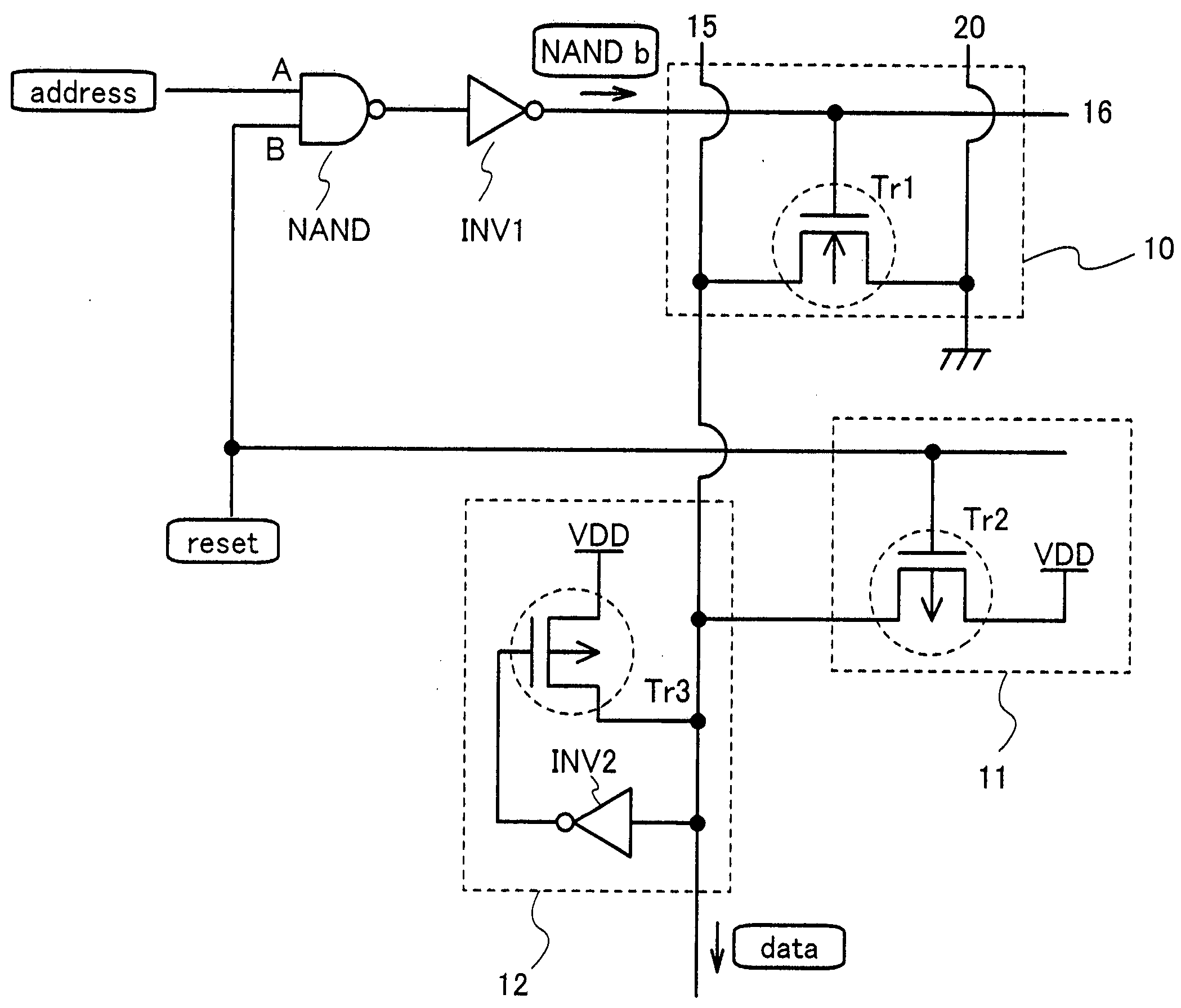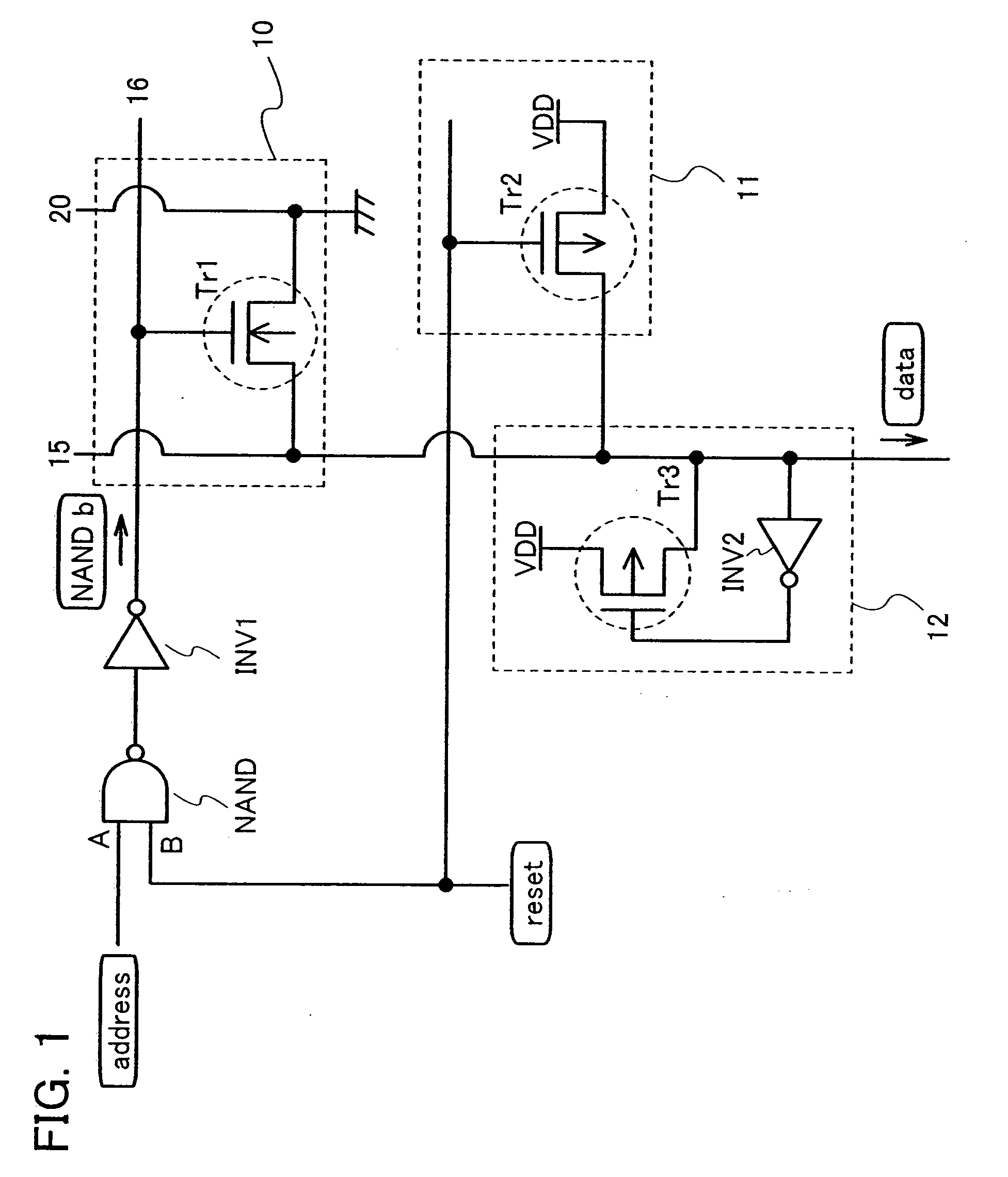Semiconductor device and operating method thereof
a technology of semiconductor devices and memory cells, applied in semiconductor devices, digital storage, instruments, etc., can solve the problems of increasing manufacturing costs, greatly affecting the integration degree of wires, etc., and achieves the effects of saving space, reducing manufacturing costs, and reliable outpu
- Summary
- Abstract
- Description
- Claims
- Application Information
AI Technical Summary
Benefits of technology
Problems solved by technology
Method used
Image
Examples
embodiment mode 1
[0039] A structure of a semiconductor device having a memory cell and the like and an operation thereof are described in this embodiment mode.
[0040]FIG. 1 shows a memory cell 10, and a precharge circuit 11 and a sense amplifier circuit 12 which are connected to the memory cell 10 through a data line 15. The memory cell 10 includes an N-channel transistor (Tr1), and a gate terminal of the transistor (Tr1) is connected to a word line 16. An inverter (INV1) and a NAND are connected to the word line 16 in series, and an address signal (address) and a reset signal (reset) are inputted to input terminals of the NAND. A signal based on the address signal and the reset signal is outputted from an output terminal of the NAND, and this signal is inverted by the INV1. This signal which has been inverted, that is an inverted signal is inputted to the gate terminal of the transistor (Tr1). The present invention is not limited to the combination of the NAND and the INV1 as long as the signal bas...
embodiment mode 2
[0051] A structure of a semiconductor device having a memory cell which is different from the aforementioned embodiment mode, or the like, and an operation of the semiconductor device are described in this embodiment mode.
[0052]FIG. 2 shows the memory cell 10, the precharge circuit 11 and the sense amplifier circuit 12 which are connected to the memory cell 10 through the data line 15. A structural difference between FIG. 1 and FIG. 2 is in that the transistor (Tr1) of the memory cell 10 is not connected to GND and in a floating state. The transistor (Tr1) in the memory cell is not connected in this manner; therefore, data can be changed by modifying either a contact mask or a wire mask at the time of rewriting data of the memory cell. Through a simple process in this manner, the data of the memory cell can be rewritten. Since the other configuration is similar, description is omitted.
[0053]FIG. 4 shows a timing chart. A series of operations which is divided into a period 5, a per...
embodiment mode 3
[0061] In this embodiment mode, as a structural example of a semiconductor device of the present invention, a wireless chip provided with a semiconductor device having a memory cell is described. A method for manufacturing the wireless chip is described below.
[0062] In FIG. 5A, a release layer 601, an insulating layer 602, and a semiconductor film 603 are sequentially formed over a substrate having an insulating surface (hereinafter referred to as an insulating substrate) 600. As the insulating substrate 600, a glass substrate, a quartz substrate, a substrate which is made of silicon, a metal substrate, a plastic substrate, or the like can be employed. In addition, the insulating substrate 600 may be thinned by polishing. By employing the thinned insulating substrate, a finished product can be reduced in weight and thickness.
[0063] The release layer 601 can be formed of an element selected from W, Ti, Ta, Mo, Nb, Nd, Ni, Co, Zr, Zn, Ru, Rh, Pd, Os, Ir, or Si, an alloy material con...
PUM
 Login to View More
Login to View More Abstract
Description
Claims
Application Information
 Login to View More
Login to View More - R&D
- Intellectual Property
- Life Sciences
- Materials
- Tech Scout
- Unparalleled Data Quality
- Higher Quality Content
- 60% Fewer Hallucinations
Browse by: Latest US Patents, China's latest patents, Technical Efficacy Thesaurus, Application Domain, Technology Topic, Popular Technical Reports.
© 2025 PatSnap. All rights reserved.Legal|Privacy policy|Modern Slavery Act Transparency Statement|Sitemap|About US| Contact US: help@patsnap.com



